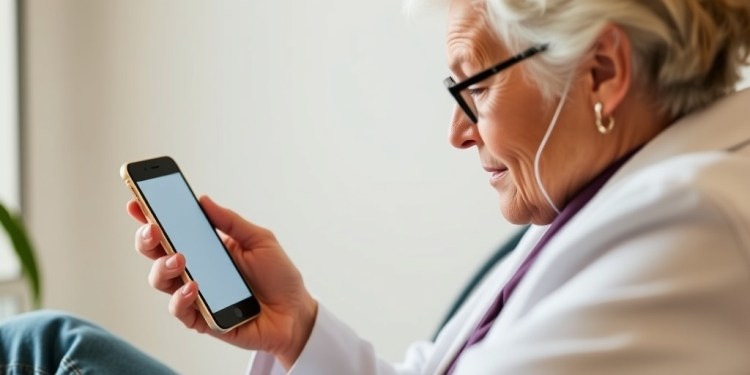In the rapidly evolving landscape of healthcare technology, the ability for older adults to communicate with their healthcare providers through digital means has transformed how medical interactions occur. Historically, this demographic relied heavily on phone calls to communicate health concerns, with even simple inquiries often necessitating an in-person visit. As the healthcare field shifts towards digitalization, recent research reveals a significant uptake in the utilization of patient portals by individuals aged 50 and older, highlighting both the benefits and potential drawbacks of this shift.
However, the study brings to light an unsettling discovery that some older adults, including those with low incomes, are facing financial charges for these ostensibly straightforward digital communications. In an era when one might presume that technology eases access to healthcare, this finding casts a shadow over the benefits. Among older adults who utilized the messaging features of their portals, about 13% reported incurring co-pays or other charges for these interactions. This financial aspect raises alarms about the equitable access to technology designed to enhance health management.
The ability for healthcare providers to bill for replies to online messages hinges on whether medical decision-making is involved, particularly if those communications require five minutes or more. This policy was facilitated by the flexibility in telehealth regulations that emerged with the onset of the COVID-19 pandemic, which has recently extended its provisions through further legislative support. As telehealth strategies continue to evolve, the financial ramifications for older adults engaging in these digital communications must be carefully scrutinized.
Investigations into the billing practices associated with patient portal messaging reveal disparities tied to insurance status. For instance, the data indicates that older adults holding private insurance recorded a billing percentage of 17% for such exchanges. The figures are similarly concerning for Medicaid recipients, where 16% encountered costs for patient portal interactions. In contrast, individuals relying on Medicare Advantage or traditional Medicare with supplemental coverage faced slightly lower billing rates—11.3% and 9.7%, respectively. Those with traditional Medicare without supplemental coverage bore an even lesser financial burden at just 5.1%, as did those covered by VA benefits, who experienced the lowest rate at 3.3%.
As the digital divide persists, the research underscores a stark contrast in technology utilization based on income levels. In a related study, older adults with incomes exceeding $60,000 demonstrated a propensity for digital device usage that was double that of their counterparts earning below $30,000. Such economic disparities reflect broader inequalities in healthcare access, necessitating urgent attention to ensure that evolving technologies do not exacerbate existing issues of disparity.
Dr. Liu suggests potential avenues for rectification, advocating for state-level transparency policies that clarify billing associated with patient portal messaging. A well-informed patient body stands a better chance of navigating their healthcare options without the burden of unexpected costs. This not only enhances the patient experience but ensures that older adults can seek medical advice without financial hesitation or fear of additional charges.
The research findings culminate in a call to action for stakeholders within the healthcare sector. While many patients find value in the advent of portal messaging, the financial implications associated with them warrant consideration as healthcare systems adapt to the digital age. Establishing a balance between the costs of these digital communications and their perceived value is crucial for maintaining patient trust and engagement.
Furthermore, as telehealth continues to be a cornerstone of modern healthcare delivery, ongoing studies will be essential to evaluate usage trends and the economic impact of digital interactions on various demographics. Understanding the nuances within these patient experiences will provide critical insights as healthcare policy evolves in response to shifting technologies and patient needs.
In conclusion, while the embrace of digital communication by older adults is encouraging, it uncovers a plethora of questions regarding access, equity, and the evolving nature of medical billing practices. Future research and policymaking must synergistically work to ensure that financial barriers do not hinder the benefits that digital health tools offer for enhancing patient-provider communication.
Subject of Research: Use of Patient Portal Messaging and Self-Reported Copays Among US Adults 50 Years or Older
Article Title: Use of Patient Portal Messaging and Self-Reported Copays Among US Adults 50 Years or Older
News Publication Date: 4-Apr-2025
Web References: JAMA Health Forum
References: doi:10.1001/jamahealthforum.2025.0168; doi:10.1001/jamanetworkopen.2024.54727
Image Credits: Michigan Medicine
Keywords
Digital Health, Older Adults, Healthcare Communication, Telehealth, Patient Portals, Health Equity, Health Insurance, Medical Economics
Tags: barriers to digital health communicationbenefits of digital healthcare for seniorscost implications of patient portalscost of portal messaging for older adultsdigital communication in healthcareenhancing access to digital health resourceshealthcare policy and older populationshealthcare technology adoption by older adultsimpact of technology on doctor-patient interactionsolder adults’ healthcare communication preferencespatient portals for seniorsveterans and digital health tools





